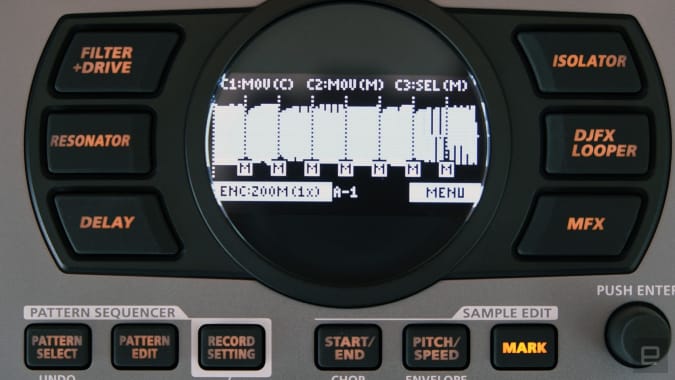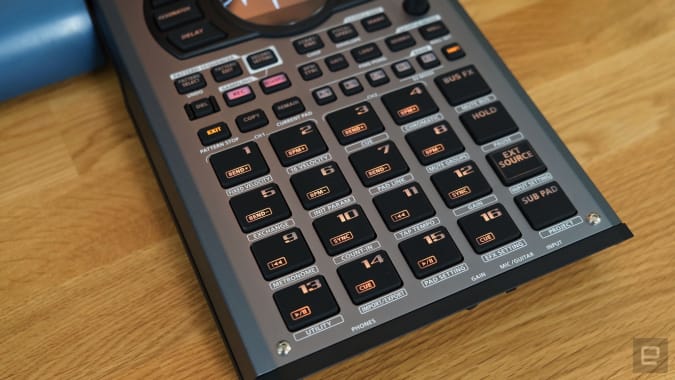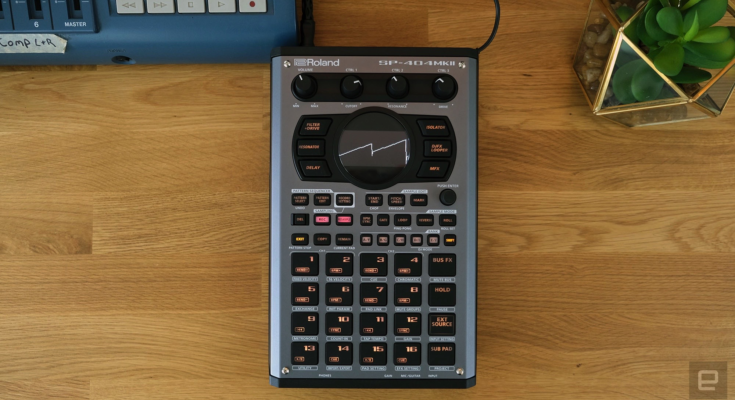The Boss and Roland line of SP samplers (specifically the SP-303 and SP-404) are some of the most important instruments in hip hop history. Right up there with the MPC and the Technics SL-1200. They’ve been used by the likes of MF Doom, Madlib and J Dilla, and are a favorite among lo-fi hip hop artists everywhere. They’ve also been used by plenty of other musicians like Panda Bear, Four Tet, Oneohtrix Point Never and even Radiohead. But, the original SP-404 was released in 2005. And even though it was succeeded by the 404SX and the 404A, those were extremely minor updates that did things like switch from the aging and slow CF Card format to SD. The new SP-404MKII, though, finally updates the classic sampler for the modern age without sacrificing what made the OG so alluring.
Physically, the 404MKII is very similar to past versions of the 404. There are four knobs across the top; a circular window below them, flanked by six effects buttons; and pads on the bottom for triggering samples. The MKII does look better than the A, at least. The 404A was designed to fit in with the rest of Roland’s AIRA line — that means stark black accented with garish red and green. It’s… a look. But not one that everyone (myself included) can get behind. The new version is a much more subdued gray and black, with white and muted orange accents.

Terrence O’Brien / Engadget
Beyond pure aesthetics, though, there are some huge upgrades in the MKII. The two most obvious differences are the detailed OLED screen that has replaced the old-school seven-segment LEDs, and the move from a 12-pad layout to a 16-pad one.
The screen represents the biggest change to the SP experience. Editing samples on an OG 404 could be painful. The three-digit LEDs gave you only generic start and end points, and because of the high resolution needed to create perfect loops, the range was very small. That would lead to having to crop a sample multiple times to take off all the excess. The OLED on the SP-404MKII is high enough resolution to show the actual waveform as it’s being edited. You can zoom in and out as needed to crop as little or as much as you want. I would go as far as to say that recording and editing samples on the MKII is not only easier, but actually kinda fun.
The 16 pads give you access to more samples and patterns to construct your beats out of. Also, the four-by-four grid has become something of a standard. It’s the layout used by Akai on the MPC, on Pioneer’s DJ gear, on the Native Instruments Maschine, Ableton’s Drum Rack and even some of the larger members of the SP family like the 808 and the 606.

Terrence O’Brien / Engadget
There are other more subtle changes as well. For one, those 16 pads on the front are all velocity sensitive, a first for the SP line. That said, it’s almost impossible to get full velocity out of them without just turning on fixed velocity. Some finger drummers especially may prefer to turn fixed velocity on to keep melodic and percussion elements consistently mixed, but it can also leave things sounding a bit robotic and unnatural. Just something to keep in mind.
Roland added MIDI out to the back of the SP-404MKII as well. The previous versions had MIDI IN only. Now the 404 can be used to sequence external gear, or even be hooked up to a PC to control your DAW via USB-C. That makes the 16-pad layout even more important, because it’ll map better to whatever you’re connecting it to most likely. Oh. and that USB port can also be used to stream audio to your PC.
This also marks the first time that Roland has ditched RCA in favor of ¼-inch jacks for the audio ins and outs on an SP. Now, this is a net positive but there is a down side. Often an SP is being used to sample directly from vinyl and most turntables use RCA. That means there will be an intermediary step to getting loops from a record to the 404. But, it does make it easier to sample directly from an instrument. Synths, drum machines, guitars and basses all generally use ¼-inch plugs. And, since the ins and outs on the MKII are balanced, it should be less susceptible to noise and interference.



